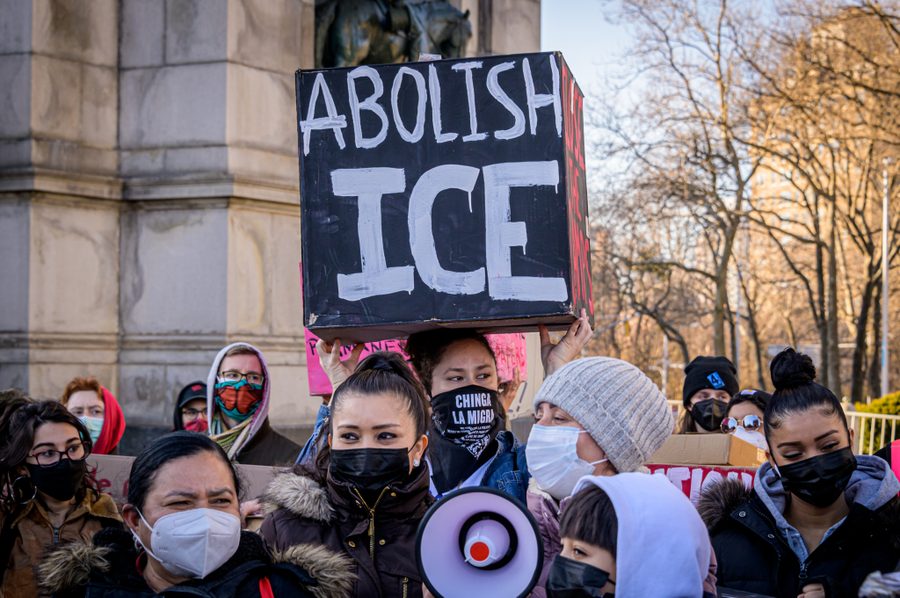Trump 2.0 Poses an Even Bigger Threat to Migrants. Here’s How We Fight Back.
Let’s take concrete action to protect the millions of US residents facing the threat of Trump’s deportation crosshairs.
Silky Shah

Editor’s Note: This article was originally published by Truthout.
This election cycle was defined — yet again — by Donald Trump’s fearmongering over immigration. Like his previous two campaigns for president, Trump fueled a racist panic over “migrant crime” and capitalized on people’s fears over economic insecurity by scapegoating immigrants for all of the U.S.’s problems, including but not limited to the housing crisis, opioid crisis and inflation. But unlike those previous elections, rather than challenging Trump’s rhetoric, the Democrats capitulated to the Republicans and solidified the rightward lurch on the issue.
Throughout her campaign, Kamala Harris repeatedly lambasted Trump for “talking a big game about securing our border” but still tanking what she referred to as “the most significant border security bill in decades.” The bipartisan Senate bill, also known as the Border Act of 2024, would have drastically gutted asylum; closed the border to people seeking safety; increased funding for immigration detention and surveillance, including the largest appropriation for custody operations in Immigration and Customs Enforcement’s (ICE) history; and even included money to complete the border wall. The few positive reforms in the bill — such as a modest increase in visas and some expanded protections for certain immigrant youth and Afghan evacuees — were crumbs amid the harsh measures that reinforced the harmful ideology that immigrants are a “security threat.” Harris often emphasized the significance of Republican support for the bill and boasted that “even the Border Patrol endorsed it.” It was a stark contrast to her Democratic primary campaign four years earlier when she supported the decriminalization of people crossing the border and declared, “Trump’s border wall is a complete waste of taxpayer money and won’t make us any safer.”
As we take stock of the politics of immigration in the U.S. after this election, including the anti-immigrant rhetoric spewed along the campaign trail, the unwillingness of the Democratic Party to provide a countervailing vision on immigration is indefensible. This moral failure robbed immigrants of their humanity and turned them into spectacles of false narratives around “public safety” and “national security.” The Democrats need to be forced to reckon with their record: Decrying Trump’s white supremacist agenda while championing one of its biggest components was never going to square with the voters they needed.
As we await the onslaught we know is coming under another Trump administration, it is imperative that we challenge these dehumanizing narratives and uplift immigrants as valuable members of our families, schools and workplaces that are worthy of dignity and support. Sadly, the Democratic Party’s strategy this election cycle will make it that much harder for us to make the case.
If the border wall symbolized Trump’s first run for president, this one was defined by the call for mass deportations. While both parties have aligned around border policy, the starkest contrast between the two is the approach to immigrants currently living in the U.S. Prior to Trump taking office in 2017, the immigrant rights movement fought back against mass deportations under Barack Obama labeling him “deporter-in-chief.” Some 400,000 immigrants were formally deported each year, meaning they were subject to a five-year bar to reenter the country and could face lengthy prison sentences if they attempted to do so. The growing outrage over mass deportations led some members of his own party, especially at the local and state level, to pass robust sanctuary laws to prevent collaborations between ICE and local police.
At the federal level, Obama was compelled to expand protections to broad categories of immigrants through programs such as Deferred Action for Childhood Arrivals and Temporary Protected Status, which allow them to live and work in the U.S. without fear of deportation. Because of these efforts and the shifted focus on the border, rampant deportations of community members have gone down considerably. In 2023 there were roughly 140,000 formal deportations.
But with Trump’s return, we can expect not only mass raids of homes, worksites and communities, but the stripping of status from millions of people. With the scale of what has been proposed, some 28 million people could be at risk of family separation in 2025.
Given the “migrant crime” panic stoked by the Republicans, we should anticipate Trump aides like anti-immigrant zealot Stephen Miller coordinating with local sheriffs to round up those they have deemed “criminal aliens.”
When formal deportations were at their height under Obama, it was largely because of programs like Secure Communities, which automated data-sharing between agencies during the booking process. Immigrants were funneled into the deportation pipeline through local jails. Obama expanded the program across the country but eventually sunset it after opposition due to racial profiling, though similar programs continue to exist. Policing and incarceration, by design, systemically criminalize Black and Brown people. Community members arrested or convicted in this unjust system are then “punished twice” with the threat of detention and deportation. While many understandably focus on the role of the private prison industry in immigration enforcement, local jails are both a site of detention and a key gateway to the deportation process. Sanctuary laws ending these partnerships will remain an important line of defense against the mass deportation agenda.
The scale of operations that have been proposed for Trump’s mass deportations will require billions of dollars. We must push to stop the injection of resources into the deportation machine and the push back against draconian immigration policies in Congress.
During Trump’s first term, a coalition of immigrant rights and progressive groups was able to block some $15 billion in additional funding to ICE and Customs and Border Protection (CBP) for the border wall, more agents and more detention beds through the Defund Hate campaign. Through political education about the budget process, exposing ICE and CBP abuses, coordinated actions, legislative advocacy and petition drives, the coalition persuaded a hundred members of Congress to call for cuts in funding to DHS.
While the movement to defund the police has faced backlash and the Democrats have retreated from their pro-immigrant stance, the broader demand to divest from immigration enforcement, the prison industrial complex and U.S. militarism, and instead invest in health care, education and social safety nets remains salient. Abolition will be an important guide as we tackle the new political terrain. Communities across the country continue to fight to end detention and develop local economies that don’t depend on incarceration.
Like during the previous Trump administration, many will turn to legal interventions as a tactic to throw a wrench in his plans. Litigation will be a critical strategy to mitigate the harm of the deportation machine, but we can’t just depend on lawyers to protect us. This was a major missed opportunity within the response to the Muslim Ban and family separation policy under Trump — what abolitionist legal scholar Derecka Purnell has referred to as “outsourc[ing] the resistance to lawyers.” Building power requires ordinary people to take a stance and organize for change. The courts will not save us, and this will be even more true in the years to come as the new administration appoints more conservative judges.
Despite the right-wing capture of the immensely destructive machinery of state, we can mount an effective resistance. And we’ve done it before. Now is the time to build up community networks to defend immigrants and other marginalized communities who will bear the brunt of the attacks from the new administration. In conservative states, especially in the South and Southwest where local officials are ready to work with the incoming Trump administration and have already passed harsh state legislation against immigrants and those that help them, we can expect the raids and enforcement actions to be even more severe.
Legal support will be essential, but so too will grassroots efforts to stop deportations. Robust individual deportation defense campaigns involving community support and actions, coordinating bond funds to get people released and advocacy with decision makers will be necessary to both prevent family separations and expose the harms of the system. Organizing campaigns to curb ICE’s reach and stop the expected massive expansion of immigration detention will be a central part of the resistance. Detention remains a key tool for facilitating deportations, and limiting the capacity to detain will help prevent deportations.
Combating the demonization of immigrants that ruled this election cycle will be no small task. Expanding the movement by educating people about their rights, exposing the harms of the system, broadening the base of support and waging campaigns against the mass deportation agenda will be critical to planting the seeds for long-term change.







